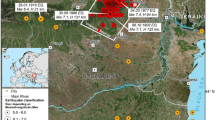Abstract
Despite the importance of spatial planning and urban planning in areas with seismic risk, urban modifiers affecting the vulnerability of buildings have not received special attention from researchers. Some international initiatives such as Benedetti and Petrini (Ind Constr 18:66–78, 1984), the EMS-98 and the Risk-UE project (2003), aware of the importance of this issue have contemplated behavior modifiers, thus ultimately increasing or decreasing the building’s vulnerability. This paper analyses urban planning in earthquake zones in order to classify urban modifiers that make cities vulnerable. To this end, the research is based on developments carried out as part of Risk-UE, in its Level I empirical methodology, and aimed at studying behavior modifiers. In order to determine the relationship between urban modifiers and damage, the researchers undertook an exploratory study of such modifiers in the city of Lorca with the aim of establishing their correlation with the damage caused by the 2011 earthquake 3 km from the city. This analysis could be useful for autonomous regions, municipalities and urban planners in establishing Urban Zoning Regulations, constructing new buildings and upgrading the seismic behavior of existing cities.
















Similar content being viewed by others
References
Applied Technology Council (1988) Rapid visual screening of buildings for potential seismic hazard—a handbook. ATC -21, California
Benedetti D, Petrini V (1984) On seismic vulnerability of masonry buildings: proposal of an evaluation procedure. Ind Constr 18:66–78
Campos-Costa A, Sousa ML, Carvalho A, Coelho E (2010) Evaluation of seismic Risk and mitigation strategies for the existing building stock: application of LNECloss in the metropolitan area of Lisbon. Bull Earthq Eng 8:119–134
Coburn A, Spence R (2002) Earthquake protection, 2nd edn. Wiley, New York, p 420
Federal Emergency Management Agency (1999) HAZUS-1999 estimated annualized earthquake losses for the United States. FEMA 336, Washington, DC
Feriche Fernández-Castanys M (2012) Elaboración de escenarios de daños sísmicos en la ciudad de Granada. Ph.D. thesis. Universidad de Granada (in Spanish)
Giovinazzi S (2005) The vulnerability assessment and the damage scenario in seismic risk analysis. Ph.D. thesis. Technical University Carolo-Wilhelmina, University of Florence
Green NB (1980) Edificación, diseño y construcción sismorresistente. Editorial Gustavo Gili, S.A. I.S.B.N: 84-252-1009-7. Barcelona, p 155
Grunthal G (1998) European Macroseismic Scale (EMS). Centre Européen de Géodynamique et de Séismologie, Luxembourg, vol 15
Guevara LT (2012) Configuraciones urbanas contemporáneas en zonas sísmicas. Editorial Sidetur. Facultad de Arquitectura y Urbanismo. Universidad Central de Venezuela, Caracas, p 374
Guevara LT, García LE (2010) The captive- and short-column effects. J Earthq Eng Res Inst Earthq Spectra 21(1):141–160
Kreditor A, Gordon P, Lagorio H, Foster H, French S, Olshansky R, Pruess J, Tobriner S, Arnold C, Eisner R, Jacobs A, Macris D, Kockelman WJ, Nader G (1990) Urban planning. Earthq Spectra 6(S1):379–391
Lagomarsino S, Giovinazzi S (2006) Macroseismic and mechanical models for the vulnerability and damage assessment of current buildings. Bull Earthq Eng 4:415–443. doi:10.1007/s10518-006-9024-z
Lantada N (2007) Evaluación del riesgo sísmico mediante métodos avanzados y técnicas GIS. Aplicación a la ciudad de Barcelona. Ph.D. thesis. Universidad Politécnica de Cataluña (in Spanish)
Lantada N, Irizarry I, Barbat AH, Goula X, Roca A, Susagna T, Pujades LG (2010) Seismic hazard and risk scenarios for Barcelona, Spain, using the Risk-UE vulnerability index method. Bull Earthq Eng 8:201–229
Mader GG (2014) Connections, the EERI oral history series, vol 22. ISBN 978-1-932884-62-3
Martínez-Cuevas S, Gaspar-Escribano JM (2016) Reassessment of intensity estimates from vulnerability and damage distributions: the 2011 Lorca earthquake. Bull Earthq Eng 14:2697–2703
Milutinovic ZV, Trendafiloski GS (2003) WP04. Vulnerability of current buildings. RISK-UE project: an advanced approach to earthquake risk scenarios with applications to different European towns. Institute of Earthquake Engineering and Engineering Seismology (IZIIS), Skopje, p 109
Molina S, Lang DH, Lindholm CD (2010) SELENA. An open-source tool for seismic risk and loss assessment using a logic tree computation procedure. Comput Geosci 36:257–269
Moya González L, Candela C, Ezquiaga JM, López de Lucio R, Suarez Carreño L, Trapero JJ (1999) La práctica del planeamiento urbanístico. Editorial Síntesis, S.A. Madrid. ISBN: 84-7738-248-4, p 278
Navarro M, García-Jerez A, Alcalá FJ, Vidal F, Enomoto T (2014) Local site effect microzonation of Lorca town (SE Spain). Bull Earthq Eng 12(5):1933–1959
Pagani M, Monelli D, Weatherill G, Danciu L, Crowley H, Silva V, Henshaw P, Butler L, Nastasi M, Panzeri L, Simionato M, Vigano D (2014) OpenQuake-engine: an open hazard (and risk) software for the Global Earthquake Model. Seismol Res Lett 85:692–702
Romão X, Costa AA, Paupério E, Rodrigues H, Vicente R, Varum H, Costa A (2013) Field observations and interpretation of the structural performance of constructions after the 11 May 2011 Lorca earthquake. Eng Fail Anal 34:670–692
Tyler MB, O’Prey K, Kristiansson K (2002) Redevelopment after earthquakes. Portola Valley, California: Spangle Associates, p 136
UNDP/UNIDO Project RER/79/015 (1985) Post earthquake damage evaluation and strength assessment of buildings under seismic condition. UNDP, Vienna, vol 4
Yépez F (1996) Metodología para la evaluación de la vulnerabilidad y riesgo sísmico de estructuras aplicando técnicas de simulación. Ph.D. thesis. Universidad Politécnica de Cataluña (in Spanish)
Acknowledgements
The authors would like to acknowledge the support of the Emergency Services Delegation of the Autonomous Community of Murcia (ESDACM); Lorca Town Hall (LTH) and Autonomous Community of the Region of Murcia (ACRM). Thanks also to other people who contributed to our work in Lorca and helped collect data during our field campaigns, in particular: Ligia E. Quirós (Universidad Politécnica de Madrid, UPM), Sara López (UPM), Oscar J. Álvarez (UPM), Sofia Gonzalez (ESDACM), María Jose Hernandez (ACRM), María García Martínez (LTH), Francisco Martínez (SGE 2.0) and Alejandro Salazar (SGE 2.0). Finally we want to thank the comments of M. Lopes and the anonymous reviewer that helped to improve this paper.
Author information
Authors and Affiliations
Corresponding author
Ethics declarations
Conflict of interest
The authors declare that they have no conflict of interest.
Rights and permissions
About this article
Cite this article
Martínez-Cuevas, S., Benito, M.B., Cervera, J. et al. Urban modifiers of seismic vulnerability aimed at Urban Zoning Regulations. Bull Earthquake Eng 15, 4719–4750 (2017). https://doi.org/10.1007/s10518-017-0162-2
Received:
Accepted:
Published:
Issue Date:
DOI: https://doi.org/10.1007/s10518-017-0162-2




